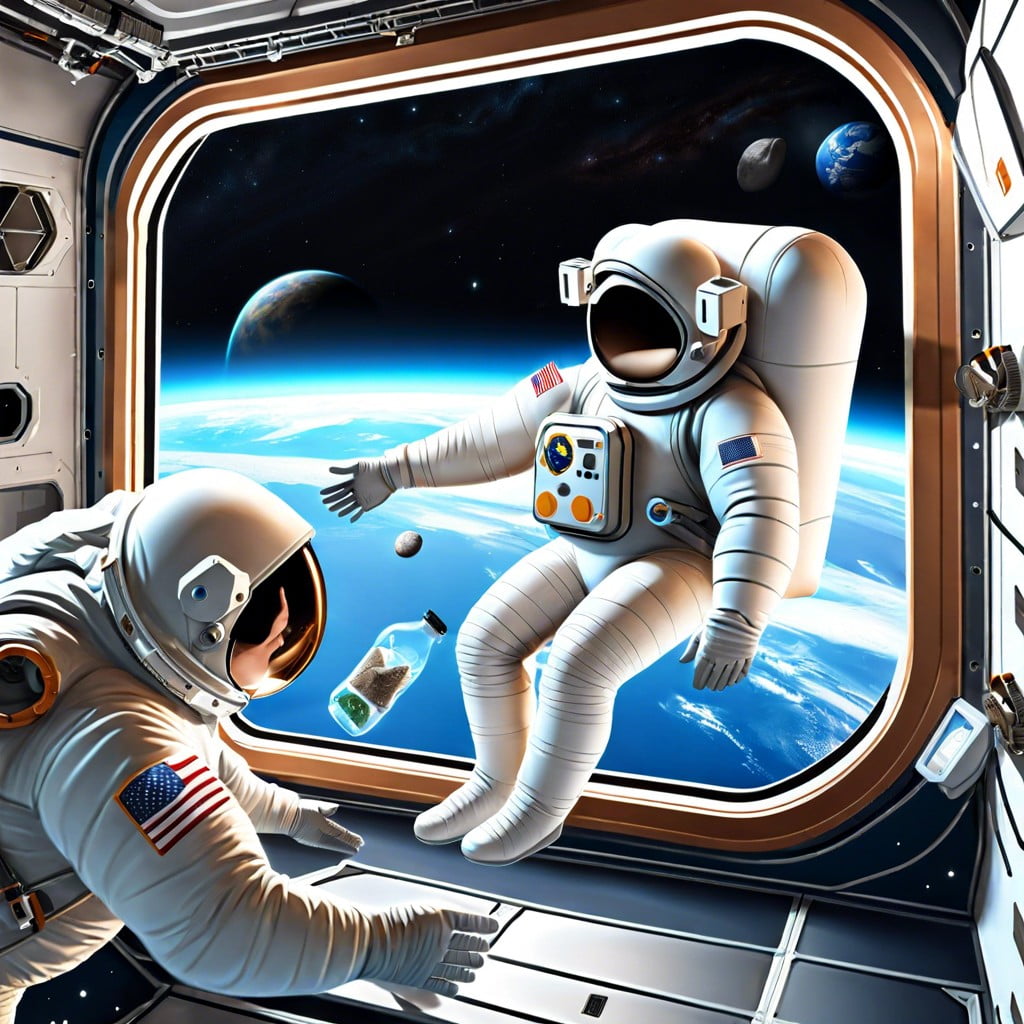Last updated on
Discover the ingenuity behind the space toilet system, which allows astronauts to manage their bodily functions while defying gravity.
Key takeaways:
- Microgravity and confined spaces make waste management challenging in space.
- Historical progression of space waste management shows necessity driving innovation.
- Advancements in space shuttle toilets included airflow-based waste removal.
- International Space Station (ISS) employs a cohesive waste management system.
- The Space Poop Challenge sparked innovative ideas for long-duration missions.
Astronaut Waste Management Challenges

Managing waste in space hinges on overcoming two main challenges: microgravity and confined spaces. In an environment where objects and fluids float freely, containing and disposing of human waste isn’t as straightforward as it is on Earth.
Microgravity turns even simple actions into complex tasks. Traditional toilets rely on water and gravity to transport waste away from the body and into the sewage system. In space, there’s no gravity to direct the waste, creating potential for harmful contamination and an unsanitary living space vital systems could be compromised.
Confinement adds another layer of difficulty. Spacecraft are designed with space optimization in mind, leaving limited room for waste management systems. Every inch onboard counts, demanding a waste solution that’s compact yet efficient.
Furthermore, ensuring the mental well-being of astronauts is crucial. Having a viable and relatively comfortable waste management system becomes a matter of maintaining morale and dignity during long missions.
To meet these challenges, substantial ingenuity is required. Solutions need to be fail-safe to prevent any leakage or spread of waste that could endanger astronaut health or critical spacecraft systems.
Safety takes precedence, but practicality and comfort are also essential. Astronauts spend months at a time in their flying habitat; the function of a toilet isn’t a mere technicality—it’s integral to their quality of life. Hence, innovation in this arena is not just about function but also about providing a semblance of normalcy in an environment that is anything but normal.
Historical Progression of Space Waste Solutions
The journey from plastic bags to high-tech systems encapsulates the fascinating progression of waste management in space. Early missions, such as Apollo, relied on the simplicity of tethered bags, where astronauts had to manually dispose of their waste, an inconvenient and often messy process. Even with sticky bags designed to adhere to the human body, the lack of gravity made containment a significant issue.
Imagine the leap from simple bags to the Skylab space station’s facilities, equipped with air-flow based contraptions. Astronauts had to attach themselves to seats with vacuums, ensuring that waste was directed away from both them and the living quarters. These systems, though a step forward, were still not perfect, but they set the foundation for future advancements.
The space toilet evolution mirrors the complexity of human ingenuity when faced with the stark challenges of living in space. With each shuttle mission, improvements were made, introducing a more familiar seated design with better suction and containment capabilities, leading the way to contemporary solutions aboard the International Space Station that would tackle both solid and liquid waste with remarkable efficiency. The historical progression of space waste management is a testament to necessity driving innovation, moving from rudimentary methods to sophisticated systems that now allow for longer missions and more comfortable conditions for astronauts.
Advancements in Toilets During the Space Shuttle Era
The conditions aboard the Space Shuttle required unique waste management systems, distinguishing itself from its predecessors with improvements in comfort and functionality. Gone were the days of the Apollo missions’ plastic bags, replaced by toilets that somewhat resembled those on Earth, albeit with necessary modifications for microgravity.
Key among these advancements was the shift to airflow-based waste removal, facilitating the separation of waste from the astronaut. The system had to be reliable to ensure that no waste could escape into the shuttle’s living quarters—quite a feat when dealing with the challenges of zero gravity.
On the space shuttle, solid waste was compacted and stored in containers that were returned to Earth, unlike liquid waste, which could be vented into space. This was a leap forward in terms of waste management, but remained a complex and not overly comfortable process.
Furthermore, personal hygiene was improved through the adaptation of these gravity-independent toilets, with attachments for males and females to manage waste separately, respecting privacy and sanitation needs in a way earlier space programs hadn’t.
This era saw the emphasis on reducing in-mission maintenance for waste systems, showing an evolving understanding of the impact of psychological and physical comfort on the success of a mission. It was a clear indication that every detail of astronaut life was under consideration, including those that are, quite literally, less glamorous.
Modern Techniques At the International Space Station
Gone are the days of rudimentary waste collection in space. Today, the International Space Station (ISS) employs a cohesive waste management system, a testament to human innovation. The lavatorial tech aboard the ISS includes a meticulously designed toilet that uses airflow to compensate for the absence of gravity, ensuring waste is efficiently directed away from the astronaut.
Moreover, the receptacles are equipped with individual fans that separate liquid and solid waste, crucial given the challenges of microgravity. These liquids are recycled and filtered back into the station’s water supply, a nod to sustainability and resourcefulness essential for long-duration space missions.
Solid waste, on the other hand, is securely contained in specialized bags that are then deposited into a trash compartment. This compartment is routinely jettisoned to burn up in the Earth’s atmosphere, a process that might seem like sci-fi but is indeed a reality.
One cannot help but marvel at the clever touch of user comfort: thigh straps and foot restraints in these compact units reinforce stability in an environment where floating off mid-task is a genuine concern. Indeed, the humility of human needs meets the heights of technological advancement aboard the ISS.
Innovations From the Space Poop Challenge
The Space Poop Challenge, spurred on by NASA, catapulted waste management technology into new realms. It wasn’t just about convenience; it tapped into aspects of hygiene and safety which are critical for long-duration missions.
Crowdsourcing innovation, the challenge led to a plethora of ideas. Among the proposals, suits with integrated waste collection systems stood out. The concept was simple: enable astronauts to not only survive but also manage their waste for up to six days without ever having to leave their spacesuits.
This sort of technology shifts our expectations about space travel. No longer are astronauts tethered to bulky machinery or conventional lavatories. Solutions involve gels, air flow, and clever materials that handle both liquid and solid waste effectively, while simultaneously combatting bacteria and odors.
Certainly, this pushes forward our dreams of Mars voyages or deep space exploration. Compact and efficient, these systems indicate a promising future where a call of nature doesn’t compromise mission safety or astronaut health.
Recap




